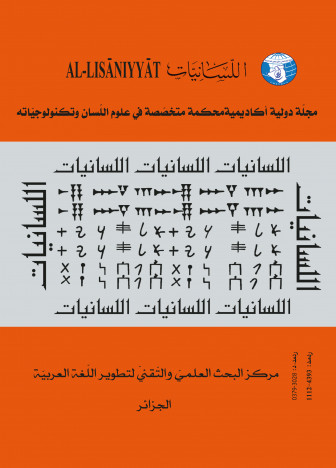HARAKA AND SUKÜN: KINETIC AND ACOUSTIC STUDIES
Main Article Content
Abstract
This work is based on the concept of haraka and sukün presented in a theoretical study published by the Professor Abderrahmane Hadj-Salah [1]. This study analyzes these two concepts in terms of articulation using a base of Arabic sounds recorded with the « articulatorygraph (AG100) » measuring device. This device computes the speed and acceleration of the organs of speech during the phonation of a sound signal. In addition, we used these records in a second study to get the characteristics of these two concepts in the acoustic level. This is done using the Praat software.
Article Details
How to Cite
Droua, G., & Abbas, M. (2012). HARAKA AND SUKÜN: KINETIC AND ACOUSTIC STUDIES. AL-Lisaniyyat, 18(2), 71-82. https://doi.org/10.61850/allj.v18i2.472
Section
Articles
References
[1] Hadj-Salah, A., 1971. «La notion de syllabe et la théorie cinético-impulsionnelle
des phonéticiens arabes», Al-Lisaniyyat : Revue Algérienne de Linguistique, VOL.1,
n°1, Institut de Linguistique et de Phonétique, université d’Alger.
[2] Huang, X., & al, 2001. «Spoken Language Processing : A Guide to Theory,
Algorithm and System Development », Foreword by Raj Reddy, Carnegie Mellon
University, Prentice Hall PTR, New Jersey, USA.
[3] Dutoit, T., 2000. «Introduction au traitement automatique de la parole», Notes de
cours /DCE2, Faculté Polytechnique de Mons, Première Edition, Belgique.
[4] http://www.praat.org
[5] http://www.wavesurfer.org
[6] Hoole, P., « Issues in the Acquisition, Processing, Reduction and Parameterization
of Articulographic Data », Munich, http://4Www.phonetik.uni-muenchen.de
des phonéticiens arabes», Al-Lisaniyyat : Revue Algérienne de Linguistique, VOL.1,
n°1, Institut de Linguistique et de Phonétique, université d’Alger.
[2] Huang, X., & al, 2001. «Spoken Language Processing : A Guide to Theory,
Algorithm and System Development », Foreword by Raj Reddy, Carnegie Mellon
University, Prentice Hall PTR, New Jersey, USA.
[3] Dutoit, T., 2000. «Introduction au traitement automatique de la parole», Notes de
cours /DCE2, Faculté Polytechnique de Mons, Première Edition, Belgique.
[4] http://www.praat.org
[5] http://www.wavesurfer.org
[6] Hoole, P., « Issues in the Acquisition, Processing, Reduction and Parameterization
of Articulographic Data », Munich, http://4Www.phonetik.uni-muenchen.de
